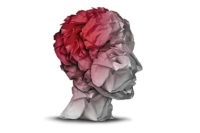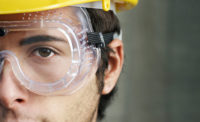The construction industry is one of the most dangerous occupations: In 2021, the construction industry experienced the most workplace fatalities1. Those in the industry are at risk for non-fatal accidents as well. One of the most common types of accidents for those in construction are slips, trips, and falls, which led to 21,400 non-fatal workplace injuries and illnesses in 2020 alone2.
Head protection, a safety helmet or a hard hat, is required by the Occupational Safety and Health Administration (OSHA) for any employees at risk of head injury from impact, falling objects, electrical shock, or burns, yet construction industry workers are still at risk. This can be even greater for those at smaller companies; Workers at construction companies with 20 employees or less have 2.5 times increased chance of experiencing a fatal traumatic brain injury (TBI) than those in larger companies3.
Understanding PPE
To get a sense of what safety measures are – and aren’t – in place, it’s telling to look back at how today’s hard hats have evolved. Hard hats can be traced back to World War I when the Hard-Boiled Hard Hat was developed out of boiled leather and metal in 1919. Inner suspensions, designed to absorb the impact of dropped objects, were created in 1928. Hard hats made out of aluminum and subsequently fiberglass were developed in the 1930s and 40s before the first plastic hard hats came about in 1951. Hard hats have since been updated to include attachments for rated chinstraps, integrated eyewear, hearing protection, and face shields. Ultimately, they remain very similar to those first introduced about 100 years ago.
Testing today’s helmets
Under the ANSI/ISEA Z89.1 standard, the two hard hat types available are Type I and Type II. While Type I hard hats are mainly constructed to reduce the force of impact to the crown of the wearer’s head, Type II hard hats are designed to reduce the force of impact to the crown, side, and back of the wearer’s head. Ultimately, Type II hard hats are designed to also address straight impacts that may occur off-center.
Helmets and hard hats must complete and meet five performance tests to be assigned their classification under the ANSI/ISEA Z89.1 standard. These tests include flammability, force transmission, apex penetration, energy attenuation, and electrical insulation. During the force transmission test, helmets must be able to reduce the force of linear impact to the crown of the head. Meanwhile, energy attenuation tests determine whether helmets can protect against impacts to the front, rear, and sides of the helmet.
Why standards fall short
While today’s helmet standards test the impact of linear forces, they do not take into account rotational motion. When a person’s head makes contact with the ground or an object, research shows this typically occurs at an angle, therefore exposing them to rotational motion. Rotational motion is the result of an oblique impact to the head, and can be described as a combination of rotational forces (angular acceleration) and rotational energy (angular velocity). In circumstances where rotational motion is transferred to the brain, this may cause shearing and damage to the brain’s axons, or cable transmitters of the neurons, when brain cells move relative to one another.
Rotational motion typically leads to diffuse injuries, such as subdural hematoma and diffuse axonal injury. Meanwhile, linear injuries, resulting from straight impacts to the head, typically lead to focal injuries, such as fractures and contusions. In most accidents, both rotational and linear motion occur at once, which increases the risk of potential injury4,5.
None of the current tests for today’s standards take into account the impact of rotational motion on the wearer’s head. In the sports and moto industries, some standards are beginning to take rotational motion into consideration, yet the construction industry has not.
Many employers in the industry are now requiring that Type II helmets, which may potentially include chinstraps, be worn. While this is an improvement from Type I helmets, which can fail to provide protection in accidents such as slips, trips, or falls if they fall off due to lack of chinstrap, traditional Type II helmets still do not address rotational motion.
Moving forward
Every accident scenario is different, but oblique or angled impacts are a much more common type of accident than linear impacts. Furthermore, research demonstrates the human brain is more sensitive to rotational motion compared to linear motion; Concussions that are caused by rotational motion occur at lower levels of energy than concussions caused by linear motion6. Despite the fact that helmet standards fail to take rotational motion into account, there are measures that workers can take. The first is education, and knowing the risks involved both on the job and from rotational motion. Additionally, prioritizing PPE usage, wearing helmets that are up to code, and conducting safe job site practices are critical. While the standards are behind on rotational motion, it’s important for workers and their employers to understand the risks, and PPE available to them.
References
- https://injuryfacts.nsc.org/work/industry-incidence-rates/most-dangerous-industries/
- https://www.bls.gov/spotlight/2022/workplace-injuries-and-job-requirements-for-construction-laborers/home.htm#:~:text=Workers%20in%20construction%20and%20extraction,falls%2C%20slips%2C%20and%20trips
- https://www.ncbi.nlm.nih.gov/pmc/articles/PMC4535168/
- Gennarelli et.al. (1987). “Directional dependence of axonal brain injury due to centroidal and non-centroidal acceleration,” in Proceedings of the 31st Stapp Car Crash Conference (Warrendale, PA: Society of Automotive Engineers).
- Gennarelli et. al. (1972). “Pathophysiological responses to rotational and translational accelerations of the head,” in Proceedings of the 16th Stapp Car Crash Conference, 1972 (Warrendale, PA: Society of Automotive Engineers).
- Kleiven, S (2007). “Predictors for traumatic brain injuries evaluated through accident reconstructions,” Stapp Car Crash J, vol. 51, pp. 81–114, Oct. 2007.



